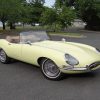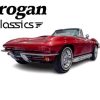1968
Description
This 1968 Autolite Lead Wedge is an electric land-speed car that was driven by Jerry Kugel to 139.893-mph at the Bonneville Salt Flats on November 19, 1968, setting a record as the world’s fastest battery-powered vehicle. The car was featured on the January 1969 cover of Motor Trend before it was donated to the Indianapolis Motor Speedway Foundation in 1973 and subsequently incorporated into the IMS Museum collection. It was last on display from 2013 to 2015 and has since been kept in the museum’s climate-controlled storage facility. The fiberglass body is finished in red with a period livery, and the car retains its General Electric direct-current motor and 20 Autolite 12-volt batteries. It has not run since it was donated to the museum and will need to be sorted prior to use. This Autolite land-speed record car is now offered by the Indianapolis Motor Speedway Foundation in Indiana with a bill of sale. The Lead Wedge was designed by Danny Eames and constructed by Eisert Racing Enterprises in Costa Mesa, California, with support from Ford’s Autolite battery division. The square-tube steel chassis is fitted with a single-piece fiberglass bodywork finished in red with white pinstripes and a period Ford, Autolite, GE, and Eisert Racing Enterprises livery. Equipment includes NACA ducts, a plexiglass windshield, and a High Voltage warning sign on the motor. The car is believed to have been repainted prior to its acquisition by the IMS Museum. The painted magnesium wheels are fitted under the bodywork and are mounted with Goodyear Blue Streak Special bias-ply tires. The rack-and-pinion steering setup was sourced from a Volkswagen. The cockpit is upholstered in quilted black vinyl and features a steering yoke, a five-point harness, a tachometer, and gauges for D.C. volts and amperage. Total mileage is unknown. The General Electric direct-current motor is retained and is linked to the rear wheels via a direct-drive setup and 20 period Autolite High-Performance 12-volt batteries that are fitted under plexiglass on either side of the chassis. The configuration is said to have been rated at 100 horsepower at 8,000 rpm when new. The car has not been run since it was donated to the museum, and sorting will be required prior to use. Located inside the famed 2.5-mile Indianapolis Motor Speedway oval, the IMS Museum is a nonprofit 501(c)(3) organization that relies on the support of visitors, members, donors, and corporate partners to make possible their daily operations, exhibits, restoration and preservation initiatives, and educational programming. To learn more about the IMS Museum and the many ways you can show support, including their “Adopt-a-Car” program, please click here.








































